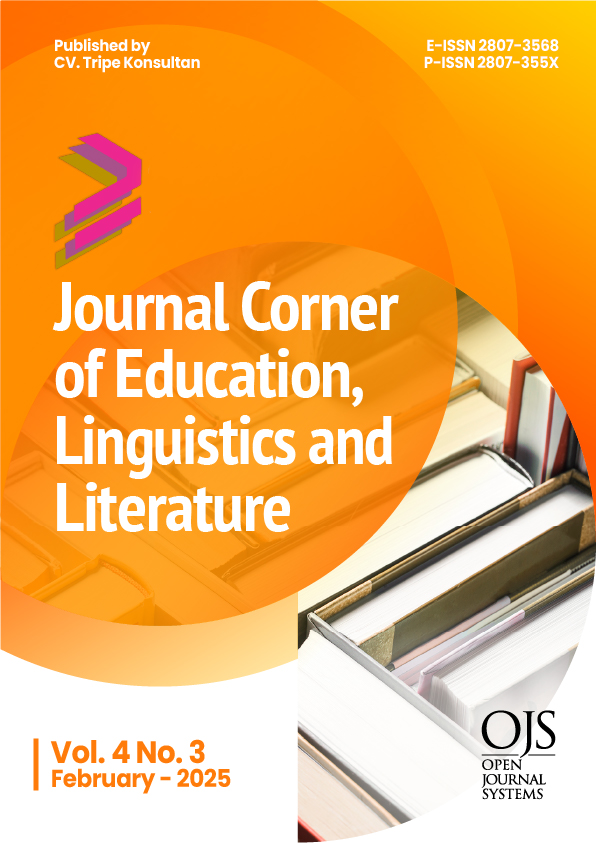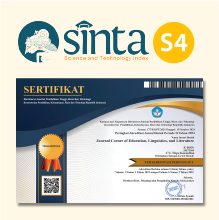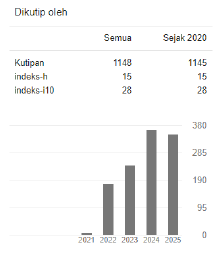Narrative Representation of Mental Health and Marginalization in Joker: A Cultural Literature Analysis
 https://doi.org/10.54012/jcell.v4i3.412
https://doi.org/10.54012/jcell.v4i3.412
 Abstract views: 1419
Abstract views: 1419
 PDF downloads: 764
PDF downloads: 764
Keywords:
cultural representation;, Joker;, marginalization;, mental health;, narrative analysis;, visual literatureAbstract
This study examines the narrative and cultural representation of mental health and marginalization in the 2019 film Joker through a qualitative approach. Framed as a form of visual literature, Joker offers a profound lens to explore the stigmatization of mental illness and the societal alienation faced by marginalized individuals. Utilizing narrative analysis and cultural studies, our study investigates key elements such as characterization, symbolism, and thematic structures to uncover how the film critiques societal attitudes and systemic failures related to mental health. The findings reveal that Joker humanizes its protagonist, Arthur Fleck, while exposing the broader societal and institutional mechanisms that perpetuate stigma and inequality. This study contributes to the growing body of literature on mental health and cultural studies by emphasizing the role of visual media in challenging dominant narratives and fostering critical discourse. The implications extend to fields such as literature, cultural representation, and education, advocating for the use of media as a tool for promoting mental health awareness and social inclusion.
Downloads
References
Andreas, R. (2021). Skizofrenia Dalam Film Joker (2019): Skizoanalisis Perspektif Deleuze Dan Guattari. Paradigma: Jurnal Kajian Budaya, 11(2), 225. https://doi.org/10.17510/paradigma.v11i2.457
Bemme, D., & Kirmayer, L. J. (2020). Global Mental Health: Interdisciplinary challenges for a field in motion. Transcultural Psychiatry, 57(1), 3–18. https://doi.org/10.1177/1363461519898035
Bina, O., Mateus, S., Pereira, L., & Caffa, A. (2017). The future imagined: Exploring fiction as a means of reflecting on today’s Grand Societal Challenges and tomorrow’s options. Futures, 86, 166–184. https://doi.org/10.1016/j.futures.2016.05.009
Bosch, B., & Kort-Butler, L. (2023). The Joker Controversy: An Origin Story. University of Nebraska-Lincoln. https://digitalcommons.unl.edu/sociologyfacpub/813/
Clarke, V., & Braun, V. (2017). Thematic analysis. The Journal of Positive Psychology, 12(3), 297–298. https://doi.org/10.1080/17439760.2016.1262613
Cockerham, W. C. (2020). Sociology of mental disorder. Routledge.
Creswell, J. W. (2016). Qualitative inquiry and research design: Choosing among five approaches. Sage publications.
Dodgson, J. E. (2017). About Research: Qualitative Methodologies. Journal of Human Lactation, 33(2), 355–358. https://doi.org/10.1177/0890334417698693
Efthymiadou, P., & Koukouvinou, P. (2020). The Joker Returns: A new perspective on the violent Clown Prince of Crime. Malmö universitet/Kultur och samhälle.
Farrell, A. E. (2011). Fat shame: Stigma and the fat body in American culture. NYU Press.
Fawcett, C., & Kohm, S. (2020). Carceral violence at the intersection of madness and crime in Batman: Arkham Asylum and Batman: Arkham City. Crime, Media, Culture: An International Journal, 16(2), 265–285. https://doi.org/10.1177/1741659019865298
Ferreira, D., Silva, E. G., & dos Santos Amaral, M. R. (2021). The Man (of) Who(m) Laughs. Linguistics and the Human Sciences, 15(2), 163–181. https://doi.org/10.1558/lhs.18384
Foucault, M. (2019). Power: the essential works of Michel Foucault 1954-1984. Penguin UK.
Goffman, E. (1963). Embarrassment and Social Organization. In Personality and social systems. (pp. 541–548). John Wiley & Sons, Inc. https://doi.org/10.1037/11302-050
Goode, E. (2022). Deviant Behavior. Routledge. https://doi.org/10.4324/9781003285304
Guest, G., MacQueen, K., & Namey, E. (2012). Applied Thematic Analysis. SAGE Publications, Inc. https://doi.org/10.4135/9781483384436
Halliwell, M. (2017). Voices of mental health: medicine, politics, and American culture, 1970-2000. Rutgers University Press.
Hammonds, K. A. (2023). An American Knightmare: Joker, Fandom, and Malicious Movie Meaning-Making.
Hammonds, K. A. (2024). Interpreting and Transmitting Kynicism in Joker: The Dark Side of Film Fandom. Rowman & Littlefield.
Hannem, S. (2022). Stigma. In The Routledge international handbook of Goffman studies (pp. 51–62). Routledge.
Hörnqvist, M. (2010). Risk, Power and the State. Routledge-Cavendish. https://doi.org/10.4324/9780203857052
Hui, A., Rennick-Egglestone, S., Franklin, D., Walcott, R., Llewellyn-Beardsley, J., Ng, F., Roe, J., Yeo, C., Deakin, E., Brydges, S., Penas Moran, P., McGranahan, R., Pollock, K., Thornicroft, G., & Slade, M. (2021). Institutional injustice: Implications for system transformation emerging from the mental health recovery narratives of people experiencing marginalisation. PLOS ONE, 16(4), e0250367. https://doi.org/10.1371/journal.pone.0250367
Kuhn, A., & Westwell, G. (2012). A dictionary of film studies. Oxford University Press, USA.
Kurzban, R., & Leary, M. R. (2001). Evolutionary origins of stigmatization: The functions of social exclusion. Psychological Bulletin, 127(2), 187–208. https://doi.org/10.1037/0033-2909.127.2.187
Lankenau, S. E. (1999). Stronger Than Dirt. Journal of Contemporary Ethnography, 28(3), 288–318. https://doi.org/10.1177/089124199129023451
Losito, S. (2024). Mental illness in India: historical, cultural and visual gap in the analyses of stigma. International Review of Sociology, 34(3), 543–568. https://doi.org/10.1080/03906701.2024.2419879
Mechanic, D., & Tanner, J. (2007). Vulnerable People, Groups, And Populations: Societal View. Health Affairs, 26(5), 1220–1230. https://doi.org/10.1377/hlthaff.26.5.1220
Mouleux, G. (2019). The Politics of Circularity in Todd Phillips’s Joker (2019). Transatlantica, 2. https://doi.org/10.4000/transatlantica.14784
Pescosolido, B. A., & Martin, J. K. (2015). The Stigma Complex. Annual Review of Sociology, 41(1), 87–116. https://doi.org/10.1146/annurev-soc-071312-145702
Phillips, T. (2019). Joker [Video recording]. Warner Bros.
Preston, J., & Rath-Paillé, L. (2023). How He Got His Scars: Exploring Madness and Mental Health in Filmic Representations of the Joker. Societies, 13(2), 48. https://doi.org/10.3390/soc13020048
Redmond, S. (2021a). That joke isn’t funny anymore: a critical exploration of Joker : Introduction. New Review of Film and Television Studies, 19(1), 1–6. https://doi.org/10.1080/17400309.2020.1864197
Redmond, S. (2021b). The loneliness of Joker. New Review of Film and Television Studies, 19(1), 65–77. https://doi.org/10.1080/17400309.2020.1861871
Roscigno, V. J. (2011). Power, Revisited. Social Forces, 90(2), 349–374. https://doi.org/10.1093/sf/sor034
Saxena, S., Thornicroft, G., Knapp, M., & Whiteford, H. (2007). Resources for mental health: scarcity, inequity, and inefficiency. The Lancet, 370(9590), 878–889. https://doi.org/10.1016/S0140-6736(07)61239-2
Storer, H. L., McCleary, J. S., Pepin, E., & Stallings, A. (2020). “That’s Why I Stay to Myself”: Marginalized Youth’s Meaning Making Processes of Social Disconnectedness. Clinical Social Work Journal, 48(1), 25–34. https://doi.org/10.1007/s10615-019-00740-0
Struch, R. (2011). Re-imagining community from the ruins: Explorations of the intersections of the theatre of the oppressed joker, community organizer, and participatory action researcher. University of Southern California.
Thoits, P. A. (2011). Resisting the Stigma of Mental Illness. Social Psychology Quarterly, 74(1), 6–28. https://doi.org/10.1177/0190272511398019
Turkel, G. (1990). Michel Foucault: Law, Power, and Knowledge. Journal of Law and Society, 17(2), 170. https://doi.org/10.2307/1410084
Tyler, I. (2018). Resituating Erving Goffman: From Stigma Power to Black Power. The Sociological Review, 66(4), 744–765. https://doi.org/10.1177/0038026118777450
Ud Din, S. S., & Shah, B. (2023). Slavoj Zizek and Film Theory: A Subjective Study of Todd Philips’ Joker. Quarterly Review of Film and Video, 1–26. https://doi.org/10.1080/10509208.2023.2254672
Wheeler, E. A. (2024). The Joker’s Shifting Face: Eighty Years of Mad History in Batman and American Culture. Journal of Literary & Cultural Disability Studies, 18(3), 369–385. https://doi.org/10.3828/jlcds.2024.17
Whitmore, A. (2021). Book Review: Gender, Race, Identity & Batman in Gotham City Living.
WHO. (2010). Mental Health and Development: Targeting people with mental health conditions as a vulnerable group. World Health Organization.
Downloads
Published
How to Cite
Issue
Section
License
Copyright (c) 2025 Ali Ridho Jamalullail, Nizam Ahzani

This work is licensed under a Creative Commons Attribution-ShareAlike 4.0 International License.
All articles published in the Journal Corner of Education, Linguistics, and Literature are licensed under the Creative Commons Attribution-ShareAlike License (CC BY-SA).

















